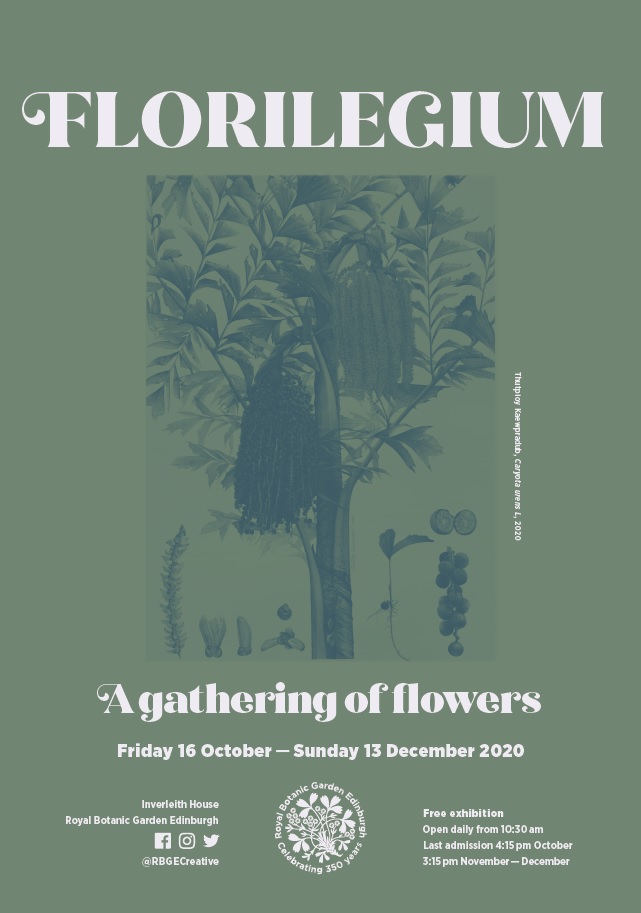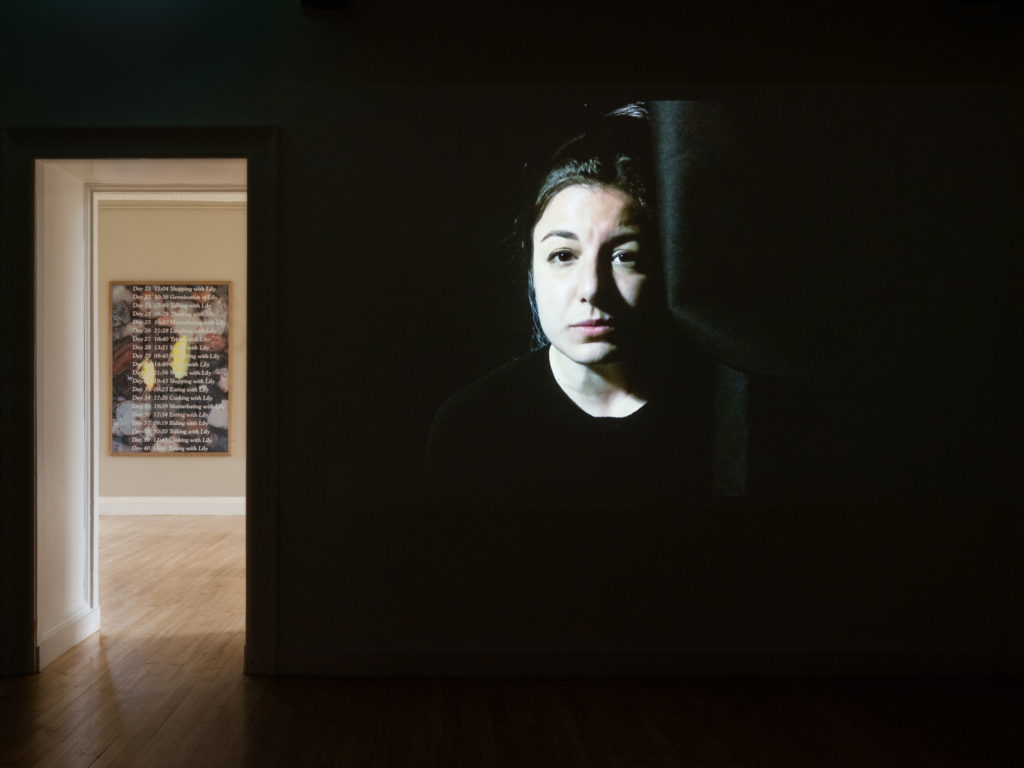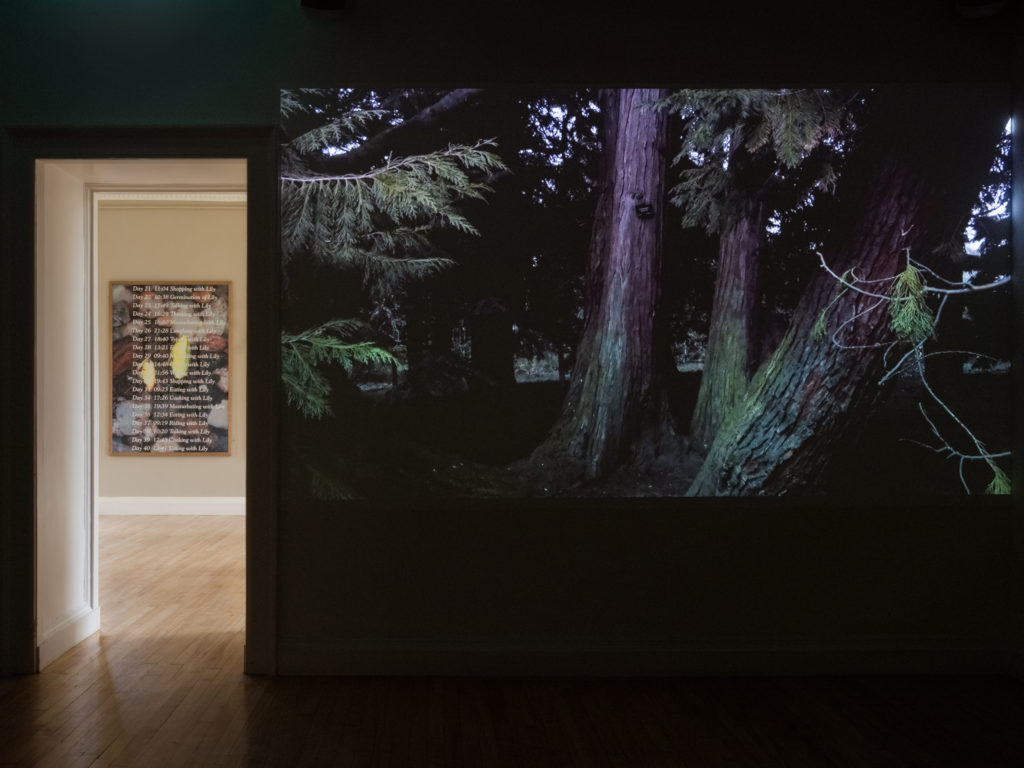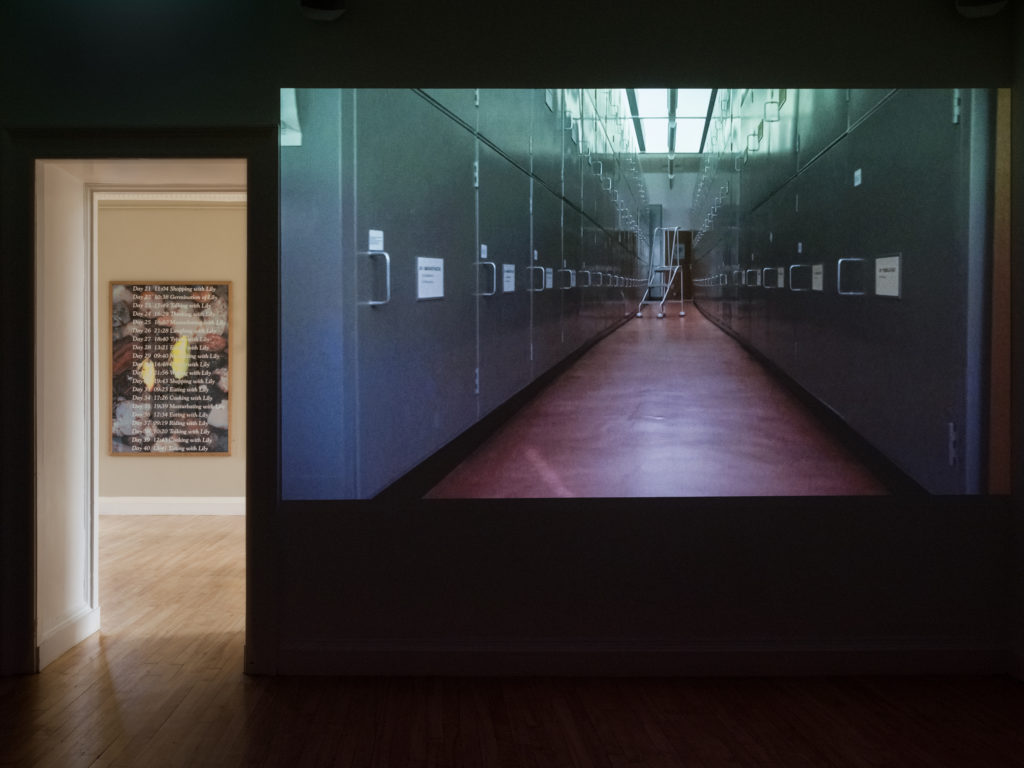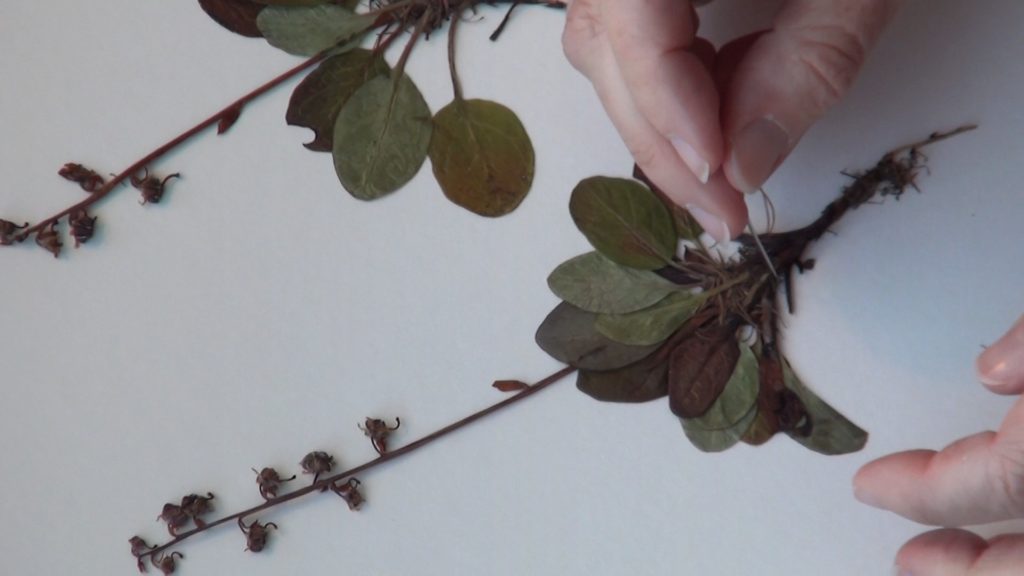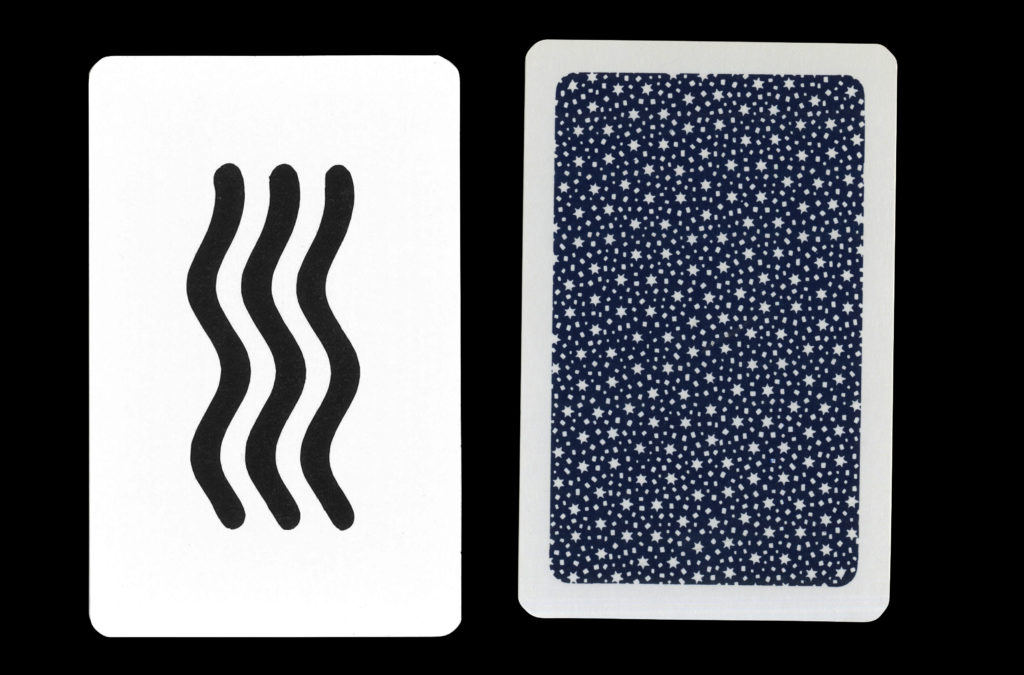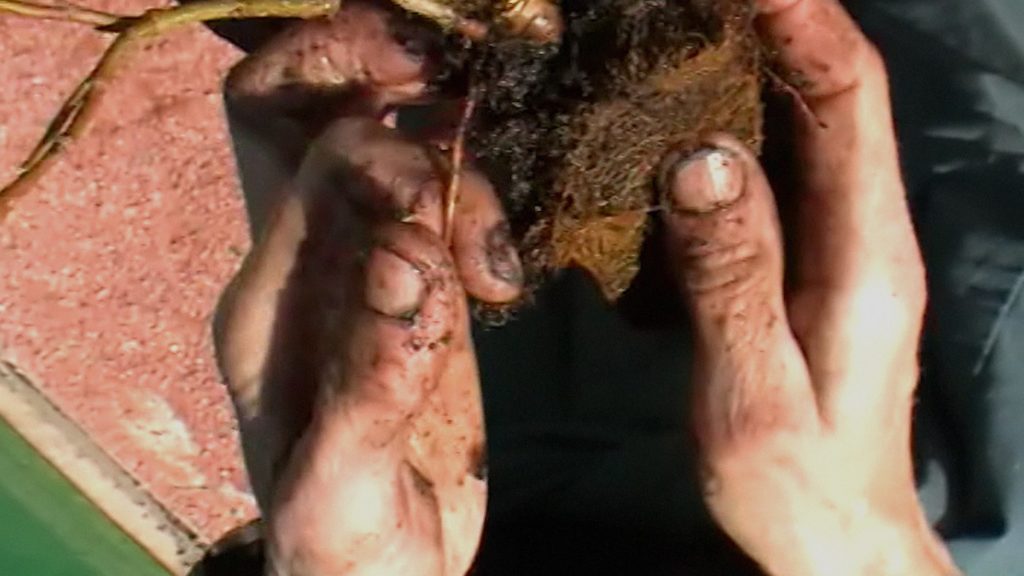In RBGE Creative Programmes’ exhibition in Inverleith House – Florilegium: A gathering of flowers, there is something for everyone. In the first room downstairs, you can lose yourself in the meticulously skilled detail of botanical paintings and illustrations, which have been contributed from around the world. Upstairs, you can meander from Wendy McMurdo’s Scottish Garden, through a Barbadian sugarcane plantation with Annalee Davis, pausing upon RBGE’s own Herbarium and Centre for Middle-Eastern plants with Lyndsay Mann, and finally travelling through a floral take on 100 days of traditional Taiwanese mourning with Lee Mingwei. As with some of the botanical paintings which illustrate the changing appearance of a plant at different moments in its life-cycle, so too do the contemporary artists upstairs sensitively approach botanicals as a meaningful metaphor for life, love and loss. These themes feel particularly pertinent in light of the challenges we find ourselves now faced with – from climate crisis to global pandemic.
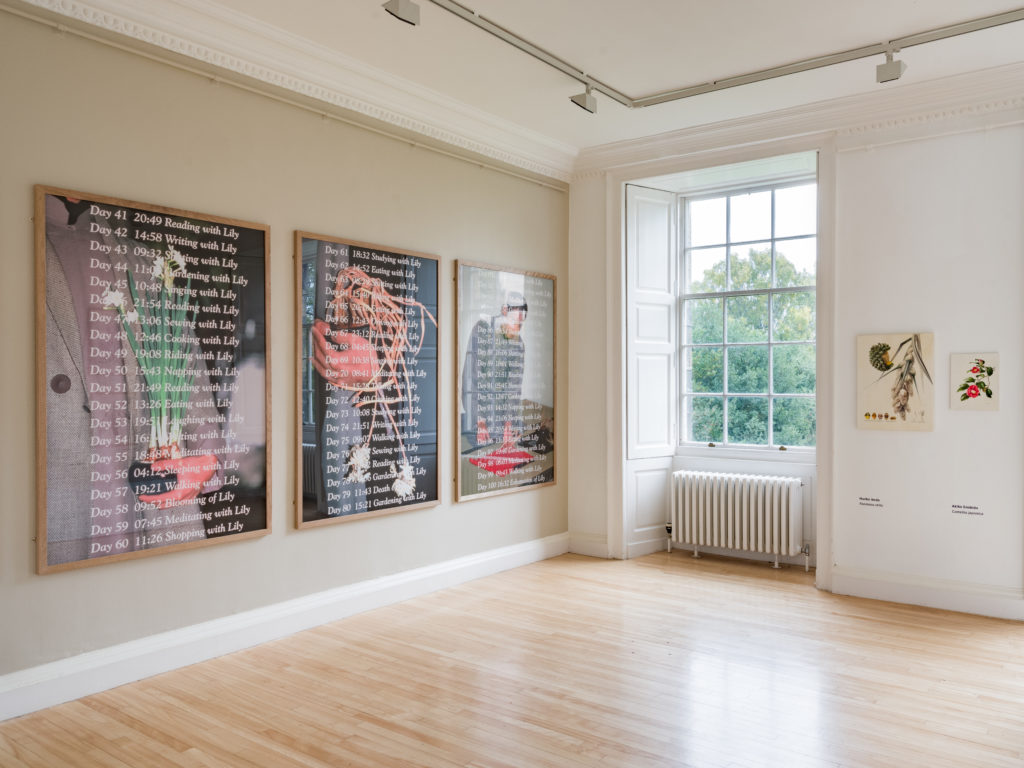
Left – Right : Lee Mingwei, 100 Days with Lily, 1995, silver dye bleach print, 166 x 115cm, 3, 4 + 5 of 5; Mariko Ikeda, Pandanus utilis, 2020, watercolour on vellum; Akiko Enokido, Camellia japonica , watercolour on vellum.
Photograph by Tom Nolan
The first room you enter into is a dizzying array of Botanical paintings – fastidiously depicting the varying colours and textures found in RBGE’s globally-important plant collection comprising over 13,500 species. From Wendy Smith’s feathery Clematis ‘Bill Mackenzie’ to Julia Asenbaum’s gleaming Hedychium cylindricum. The exhibition’s title Florilegium: A gathering of flowers derives from the name for a group of botanical artworks and is part of RBGE’s ambitious project to catalogue the plant collection through botanical and contemporary art responses. Many of the artists – living and working internationally – have overcome the challenges of a global pandemic this year to create new and never seen before works of art for Florilegium. The biennial exhibition is the first of a new programme as Inverleith House begins its transformation into Climate House following the award of the Outset Contemporary Art Fund’s Transformative Grant.
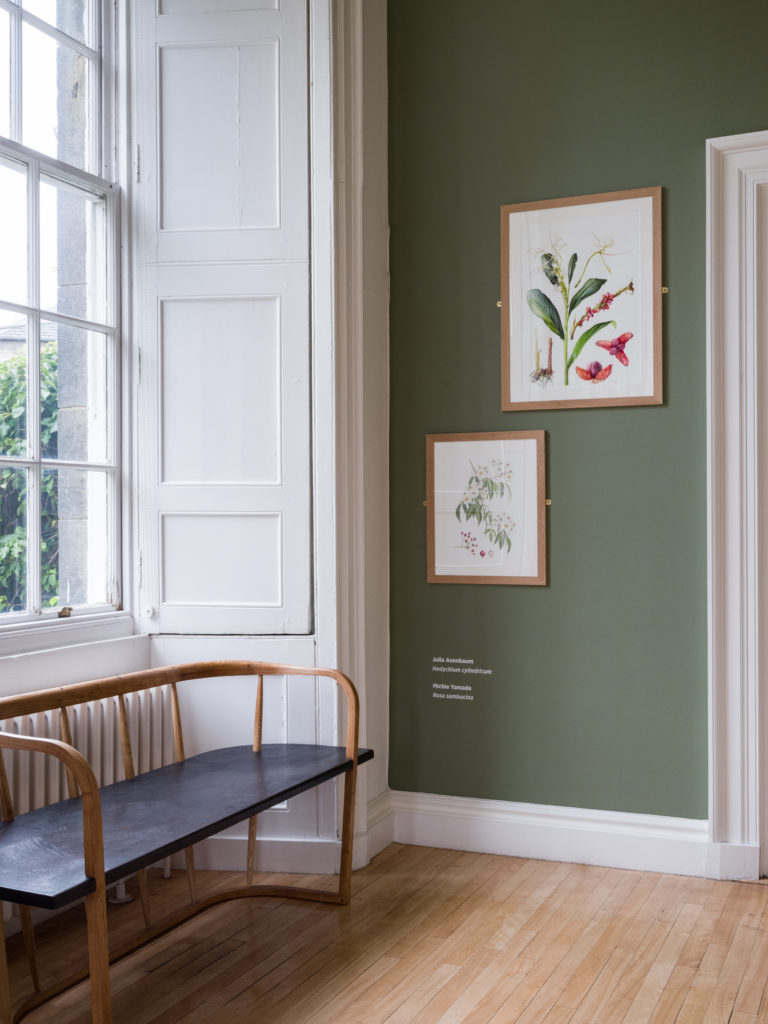
Left – Right : Michie Yamada, Rosa sambucina, Watercolour; Julia Asenbaum, Hedychium cylindricum, Watercolour.
Photograph by Tom Nolan
When you ascend to the first floor you are greeted by a striking gathering of 5 photographs by Wendy McMurdo – Night Garden –depicting the growth in Wendy’s garden during lockdown. On the bordering wall, McMurdo’s tender writing about three simultaneous happenings – lockdown, the loss of her mother, and the unexpected flowering of a Cardiocrinum giganteum – sits poignantly in white text against a deep blue wall. As McMurdo writes under the heading Out of the dark, a lily grows:
‘As my mother became ill and was quickly admitted to hospital, the unfurling leaves of the mystery plant were identified by my tree surgeon brother-in-law (one of the rare visitors to the garden in the months of deep lockdown) as belonging to a very special Cardiocrinum giganteum.’
…
‘For a plant of such an amazing height, the seeds are fragile and can apparently be difficult to germinate – if indeed they appear at all. Sowing the seeds – for the novice gardener at least – can seem like a triumph of hope over experience, so exotic and rare are they in suburban city gardens.’
‘After germination, the Cardiocrinum giganteum takes seven years to flower, with the main bulb then dying. The plants however can be propagated by bulbils, which run from the original plant.’
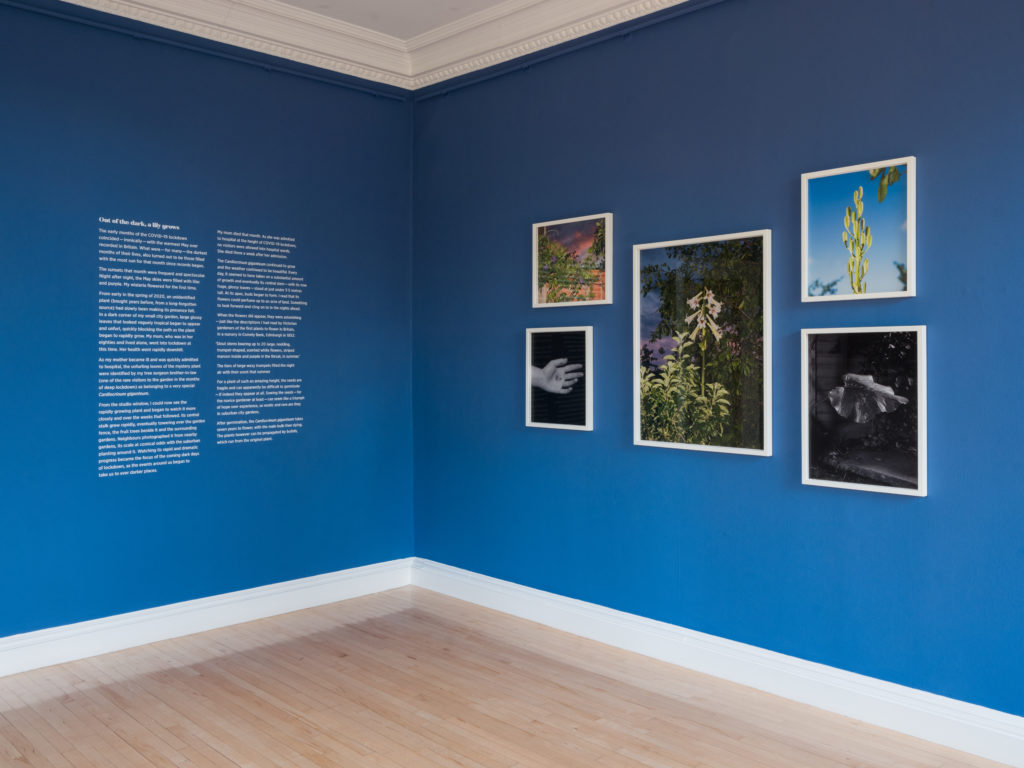
Wendy McMurdo, Night Garden, 2020, Photographic C-type prints.
Photograph by Tom Nolan
Four of the five photographs in the Night Garden series are taken at differing stages of the plant’s life-cycle, creating an easy echo with the botanical paintings on the floor below. One of the two black-and-white photographs show a declining leaf, mournfully stretching out and drooping before the camera. This room offers a tender take on human/garden ecology.
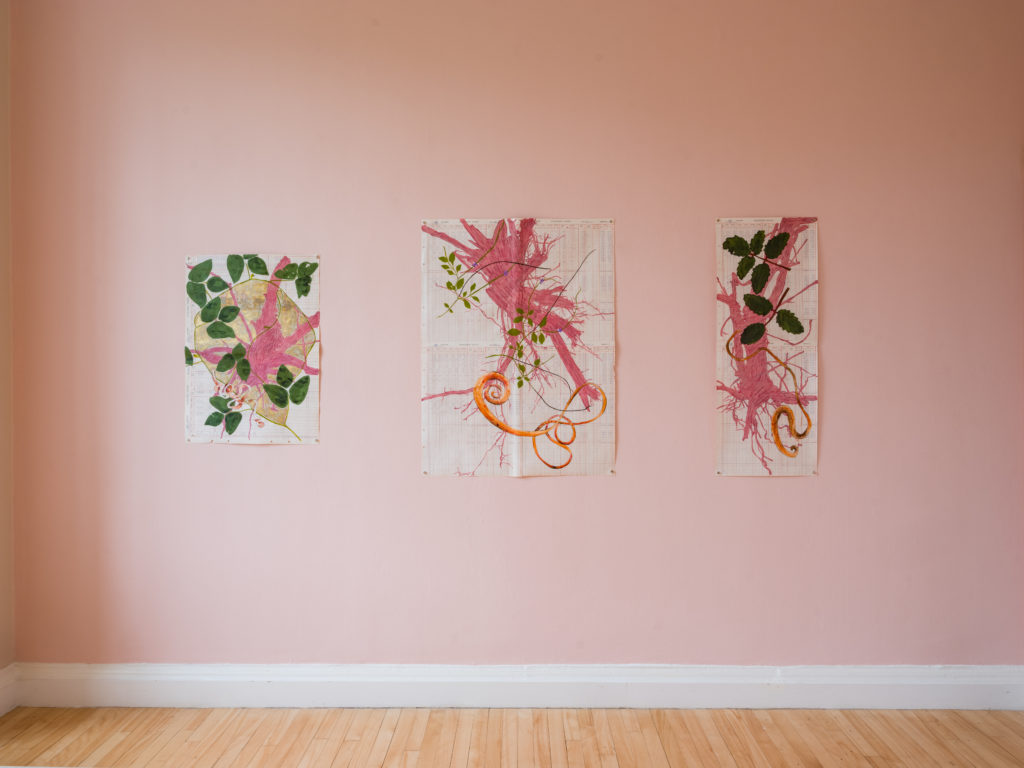
Annalee Davis, As if the Entanglements Of Our Lives Did Not Matter, 2019-20, Mixed media drawings on paper and ledger paper.
Left – Right : Bread and Cheese; Blue Vervain; Wonder of the World.
Photograph by Tom Nolan
The next room’s softly pink walls are adorned with Annalee Davis’ alluring yet disquieting series of drawings: As If The Entanglements Of Our Lives Did Not Matter. This suite of drawings is critically rooted in the context of her studio – situated on the historical site of a 17th-century sugarcane plantation in Barbados. As If The Entanglements Of Our Lives Did Not Matter includes two family portraits that reference her mixed Caribbean heritage, alongside six drawings on ledger pages, grounding these images in the history of the plantation system. In these works, she rewrites singular human and botanical narratives, through the inclusion of resilient plants which sprung up in spite of colonial attempts to ensure only the growth of sugarcane. Amongst these are Vervain, Bread and Cheese, Common Sow Thistle, Lady Palm, Paw-Paw, Sugar Cane, and Wonder-of-the-World. These irrepressible plants are depicted overlaying the roots and plantation ledgers in this series of works, firmly asserting their presence in the history of sugarcane plantations. Some of these also had herbalist properties – offering healing to both humans and the land. The final two works in the series feature Davis’ own ancestors. As If the Entanglements Of Our Lives Did Not Matter: Ivy shows Davis’ grandmother with her two great-grandparents. Due to race law, these family members could not be together. Defiantly and tenderly, they find themselves finally united in this painting, surrounded and adorned by floating wild botanicals – one of which – Ivy – points to the name of Davis’ grandmother.
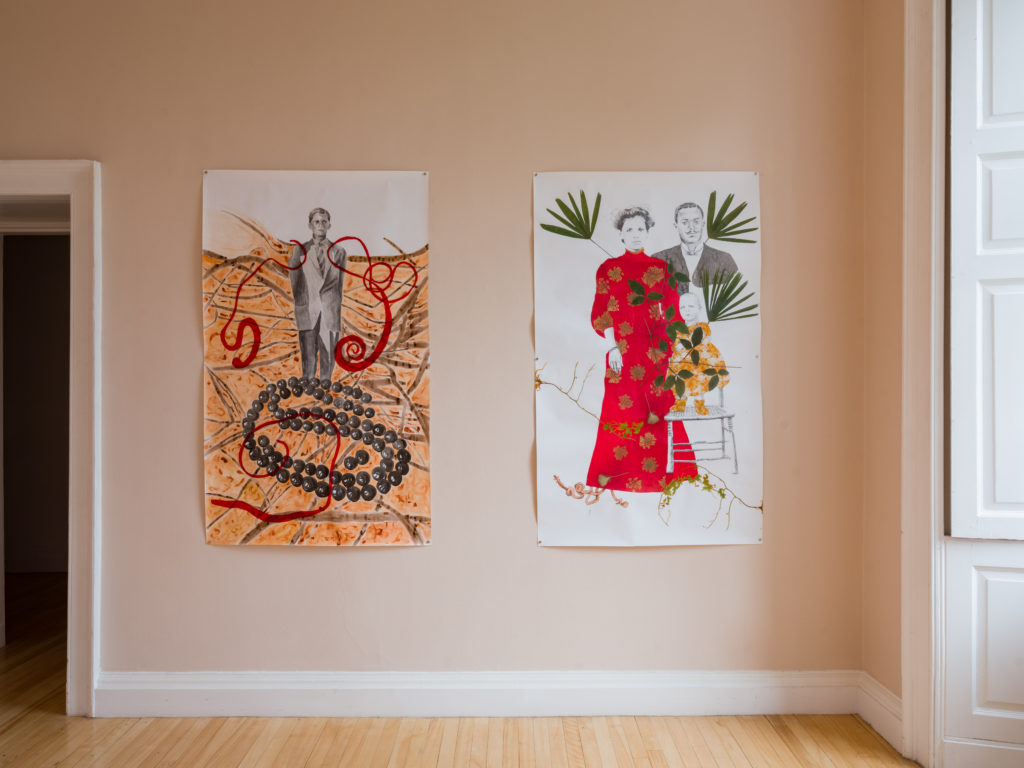
Annalee Davis, As if the Entanglements Of Our Lives Did Not Matter, 2019-20, Mixed media drawings on paper and ledger paper.
Left – Right : Pearl; Ivy.
Photograph by Tom Nolan
In the midst of this emotively, historically-charged room, there is a display cabinet containing a series of specimens from the Herbarium (relating to the plants depicted in the series of paintings). The context of Davis’ work throws a stark light onto these specimens: historically, colonial expeditions would set out to collect specimens in order to catalogue and control the natural wealth of countries. Furthermore, the care that went into preserving examples of the botanical cultures in colonised countries was a courtesy rarely extended to the people living there. All of these suggested and explicit narratives intertwine between paintings and herbarium specimens – showing that the entanglements of these (extra)human lives did, and do, matter.
Left – Right : Lee Mingwei, 100 Days with Lily, 1995, Silver dye bleach print, 166 x 115cm, 2 of 5; Lyndsay Mann, A Desire For Organic Order, 2016, 56 minutes.
Photographs by Tom Nolan
Moving through to Lyndsay Mann’s cinematic essay A Desire For Organic Order, we are again pushed to consider the role of herbaria, and botanical gardens, in human history. Mann poetically digs deep into RBGE’S soil to trace the roots of the Royal Botanic Garden Edinburgh, and botany more generally. Travelling through a wealth of sources – from Linnaeus to her own grandfather’s letters, it’s difficult to keep track, although Mann does list her sources at the beginning, and uses a footnote number to refer back throughout. She verbally lingers on notions of belonging and nativeness, interwoven with footage of international specimens being prepared for storage in our own Edinburgh herbarium. The intermittent pauses of blank screen in between, offer space for thought and reflection, in what might otherwise feel an overwhelming experience. The intimacy of Mann’s hushed Scottish tones as she takes you on a push-and-pull tour of the Herbarium and our Centre for Middle Eastern Plants, also help to soften the blow. In case you aren’t able to travel to RBGE for this exhibition, her film is also available online.
Travelling through to the final rooms you are greeted by a striking row of photographic prints, overlain with rhythmic text:
‘Day 64 15:40 Riding with Lily
Day 65 20:10 Eating with Lily
Day 66 12:43 Driving with Lily
Day 67 23:12 Reading with Lily’ …
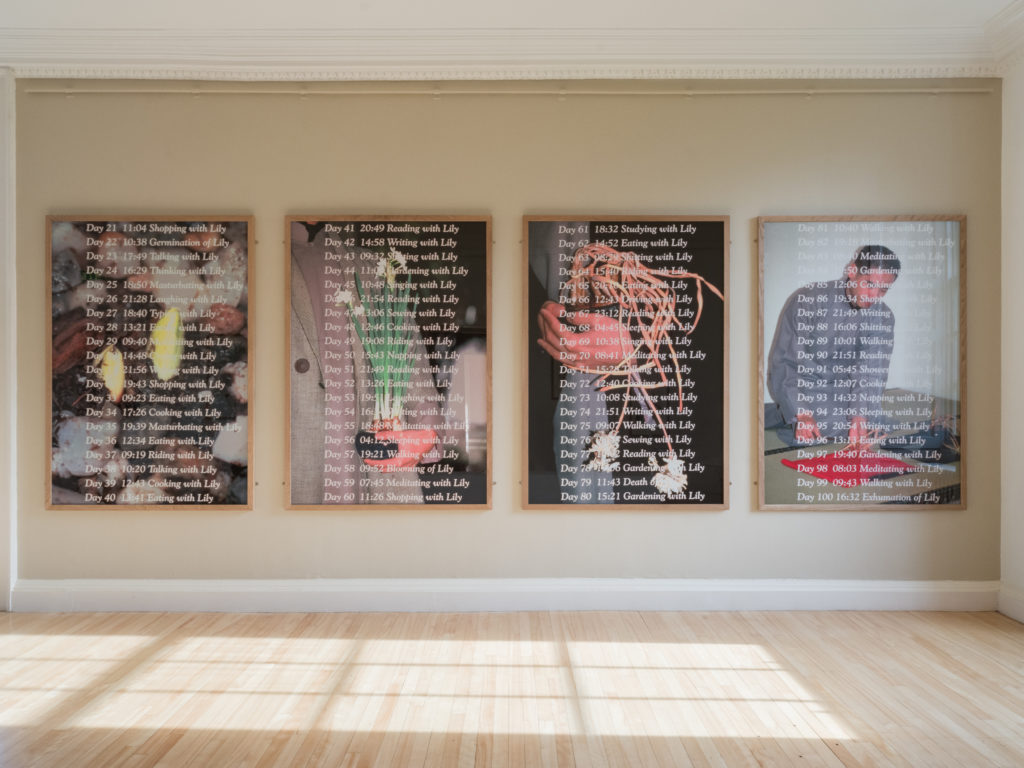
Left – Right : Lee Mingwei, 100 Days with Lily, 1995, silver dye bleach print, 166 x 115cm, 2, 3, 4 + 5 of 5
Photograph by Tom Nolan
This is one of the earliest durational works of Taiwanese-American artist Lee Mingwei – 100 Days with Lily, and was created in response to the passing of his maternal grandmother. Mingwei decided to spend 100 days with a ‘lily’ – his childhood name for a narcissus. He recorded the various daily rituals and moments spent with the plant throughout the 100-day period – intersecting the horticultural moments of planting, germination, blooming, death and exhumation, with the human moments of laughing, eating, napping and meditating. For each of the days – a moment shared between Mingwei and the ‘lily’ is textually documented, then grouped with moments from 18 other days and placed over a photograph of their shared time together. Through this, Mingwei has made the normally private process of grieving, public. After ‘Death of Lily’ on day 79, Mingwei carried the plant with him for a further 31 days, until ‘Exhumation of Lily’ on day 100. Being a perennial, the narcissus bulb was then replanted, ready to bloom again next spring – marking the cyclical nature of life and death. This work is particularly touching in its display alongside the botanical paintings of Lizzie Sanders – a much loved friend of many here at RBGE, who sadly passed away on the 24th of July earlier this year. Sanders made her beautifully meticulous botanical paintings for over thirty years, using a dry brush technique with watercolours. Living close to RBGE, she obtained many of her specimens from here – often opting for ‘bold, structural plants which themselves make a grand statement and which lead to careful, sometimes unconventional, composition’. She tutored many aspiring botanical illustrators and painters through the Diploma in Botanical Illustration at RBGE. Her carefully-rendered works are held in numerous international collections, including our own in Edinburgh.
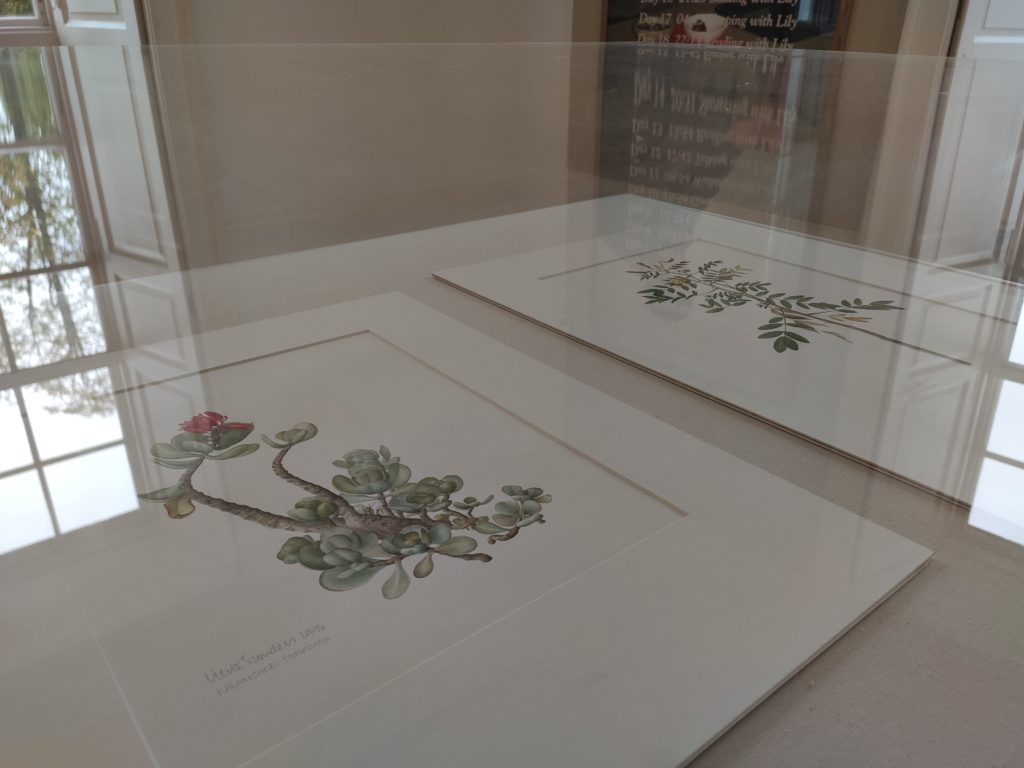
Left – Right : Lizzie Sanders, Kalanchoe farinacea, 1996; Lizzie Sanders, Senna socotrana, 1999. Also visible in the reflection of the display case: details from Lee Mingwei’s 100 Days With Lily, 1995, Silver dye bleach print, 166 x 115cm, 1 of 5.
100 Days with Lily isn’t Mingwei’s only work in Florilegium; just before you leave the room, a piece of text on the wall alerts you to the virtual inclusion of Invitation for Dawn. This is this work’s second iteration and was originally conceived as a digital alternative to his show at Gropius Bau in Berlin which had to close earlier this year due to the COVID-19 pandemic. The exhibition:禮 Li, Gifts and Rituals was a retrospective spanning the past three decades of Mingwei’s practice – focusing on his tendency to investigate rituals of giving and receiving. Invitation for Dawn derives from Sonic Blossom (2013), in which a classically trained singer would gift a song from Austrian composer Franz Schubert’s extensive collection of Lieder to a single sitter in the gallery space. Re-imagined for this current time of limited physical contact, a song is now virtually gifted over video call in a one-on-one live performance. This feels a particularly emotive and intimate experience during a period of social isolation – a tender, caring gift to receive.
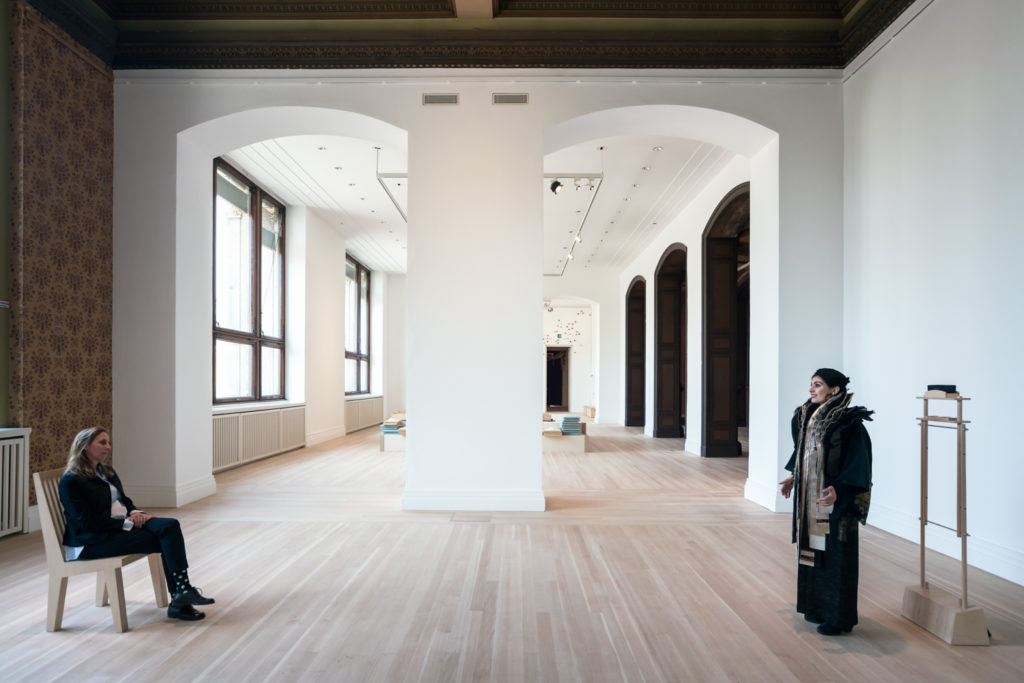
Photograph by Laura Fiorio
Florilegium: A gathering of flowers
10.30am – 3.00pm, Friday 16 October – Sunday 13 December 2020
Inverleith House, Royal Botanic Garden Edinburgh
FREE Admission. Book your time slot to enter the Garden via rbge.org.uk
If you wish to sign up to Invitation for Dawn¸ which runs until Friday 11th December, please email creativeprogrammes@rbge.org.uk


